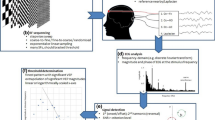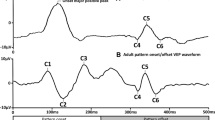Abstract
Visual evoked potentials (VEPs) can provide important diagnostic information regarding the functional integrity of the visual system. This document updates the ISCEV standard for clinical VEP testing and supersedes the 2009 standard. The main changes in this revision are the acknowledgment that pattern stimuli can be produced using a variety of technologies with an emphasis on the need for manufacturers to ensure that there is no luminance change during pattern reversal or pattern onset/offset. The document is also edited to bring the VEP standard into closer harmony with other ISCEV standards. The ISCEV standard VEP is based on a subset of stimulus and recording conditions that provide core clinical information and can be performed by most clinical electrophysiology laboratories throughout the world. These are: (1) Pattern-reversal VEPs elicited by checkerboard stimuli with large 1 degree (°) and small 0.25° checks. (2) Pattern onset/offset VEPs elicited by checkerboard stimuli with large 1° and small 0.25° checks. (3) Flash VEPs elicited by a flash (brief luminance increment) which subtends a visual field of at least 20°. The ISCEV standard VEP protocols are defined for a single recording channel with a midline occipital active electrode. These protocols are intended for assessment of the eye and/or optic nerves anterior to the optic chiasm. Extended, multi-channel protocols are required to evaluate postchiasmal lesions.




Similar content being viewed by others
Notes
A major determinant of the waveform of a VEP is the temporal frequency of the stimulus. At rapid stimulation rates, the waveform becomes approximately sinusoidal and is termed steady-state VEP. VEPs recorded with stimulation at lower temporal frequencies are termed transient VEPs.
Michelson contrast = {[L max − L min]/[L max + L min]} × 100 %, where L = luminance, max = maximum of the white squares and min = minimum of the black squares.
References
Odom JV, Bach M, Brigell M, Holder GE, McCulloch DL, Tormene AP (2010) ISCEV standard for clinical visual evoked potentials (2009 update). Doc Ophthalmol 120:111–119
McCulloch DL, Marmor MF, Brigell MG, Hamilton R, Holder GE, Tzekov R, Bach M (2015) ISCEV Standard for full-field clinical electroretinography (2015 update). Doc Ophthalmol 130:1–12 (Erratum: Table 1 in the above publication gives an incorrect number as the lower bandpass for dark-adapted OPs. The correct value is “75 Hz”, as correctly stated on page 8, 2nd paragraph)
Hood DC, Bach M, Brigell M, Keating D, Kondo M, Lyons JS, Marmor MF, McCulloch DL, Palmowski-Wolfe AM (2012) ISCEV standard for clinical multifocal electroretinography (2011 edition). Doc Ophthalmol 124:1–13
Bach M, Brigell MG, Hawlina M, Holder GE, Johnson MA, McCulloch DL, Meigen T, Viswanathan S (2013) ISCEV standard for clinical pattern electroretinography (PERG)—2012 update. Doc Ophthalmol 126:1–7
Marmor MF, Brigell MG, Westall CA, Bach M (2011) ISCEV standard for clinical electro-oculography (2010 update). Doc Ophthalmol 122:1–7
Brigell M, Bach M, Barber C, Moskowitz A, Robson J (2003) Guidelines for calibration of stimulus and recording parameters used in clinical electrophysiology of vision. Doc Ophthalmol 107:185–193
American Clinical Neurophysiology Society (2006) Guideline 5: guidelines for standard electrode position nomenclature. J Clin Neurophysiol 23:107–110. https://www.acns.org/
Acknowledgments
ISCEV’s standardization process requires the active participation of individual ISCEV members who act as consultants to the committee which writes the standard.
Author information
Authors and Affiliations
Consortia
Corresponding author
Ethics declarations
Conflict of interest
The authors declare that they have no conflict of interest
Rights and permissions
About this article
Cite this article
Odom, J.V., Bach, M., Brigell, M. et al. ISCEV standard for clinical visual evoked potentials: (2016 update). Doc Ophthalmol 133, 1–9 (2016). https://doi.org/10.1007/s10633-016-9553-y
Received:
Accepted:
Published:
Issue Date:
DOI: https://doi.org/10.1007/s10633-016-9553-y




